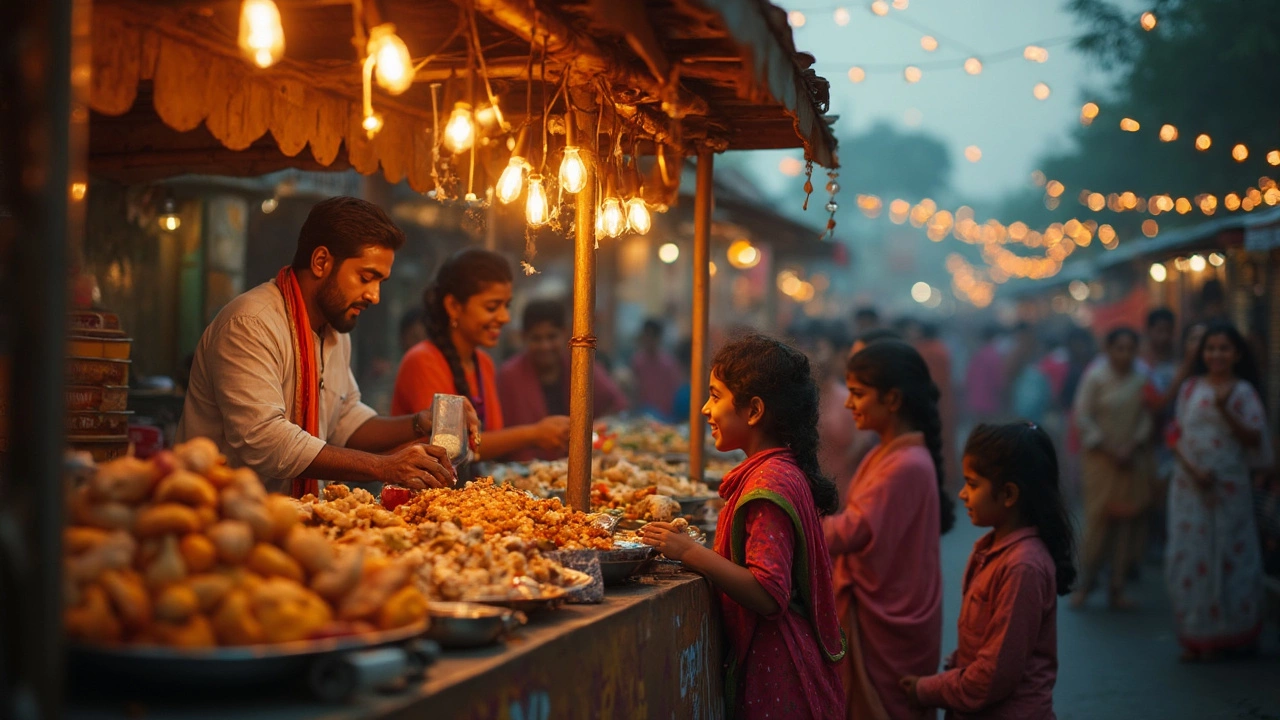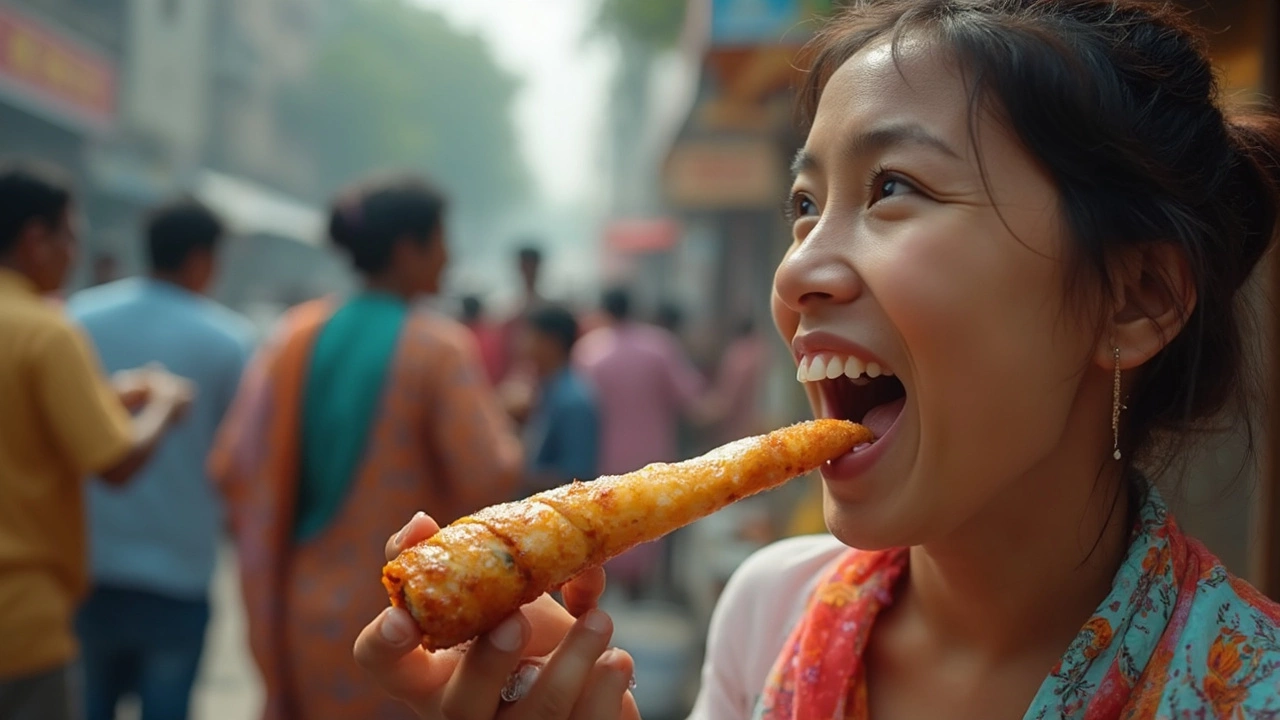Tastiest Street Food in India: What Tops the List?
 May, 1 2025
May, 1 2025
Ever wondered why Indian street food seems to pop up in every food-lovers bucket list? It isn’t just about the taste—though that’s a big deal—it’s the sheer excitement. From the roadside carts loaded with spices you can smell a block away, to the tiny stalls that locals swear by, there’s a whole culture on the curbside.
Let’s cut through the noise: some snacks have actual cult followings. Like, you’d find long queues for pani puri in Mumbai even late at night. Or, people taking train detours for a Kolkata kathi roll. Locals trust street food vendors more than fancy places sometimes, just because the recipes haven’t changed for generations.
But here’s what’s really useful if you want the best bite: watch where the crowds go. If there’s a line, odds are the food is worth it. And try asking locals for their favorite spot—they’ll usually spill every detail down to their top chutney pick. Carry cash (not everywhere takes cards) and start with small portions, so you can sample a bunch without stuffing yourself too soon.
This isn’t about just eating—it’s about being part of a living, breathing street food frenzy. And if you know what to look for, you’ll never have a boring meal again, no matter which Indian city you land in.
- Why Street Food Rules India’s Taste Buds
- Most Popular Street Eats by Region
- Hidden Gems and Insider Secrets
- How to Eat Street Food Safely and Smartly
Why Street Food Rules India’s Taste Buds
Ask anyone who’s grown up in India, and they’ll tell you: Indian street food isn’t just a quick snack, it’s a full-on flavor adventure. More than 2.5 million street food vendors serve almost 10% of meals people eat outside their homes, according to a 2023 FSSAI survey. That’s huge. So what’s driving this obsession?
First off, variety. You can get crispy samosas, tangy bhel puri, spicy pav bhaji, and sweet jalebis—all without stepping into a restaurant. Each region has its own signature treats, and recipes often get tweaked depending on the city or even the vendor. So, no two plates taste exactly the same. This keeps people coming back to try new versions and family recipes handed down for decades.
The flavors pack a punch. Most tastiest food in India comes with bold, layered spices and chutneys—salty, spicy, sour, and sweet—leaving your taste buds buzzing. You’ll often spot folks chatting around a food cart, licking their fingers, and arguing about whose chole bhature is the best. It’s not just eating, it’s a whole event.
Price matters too: street food is famously cheap. You can eat well for the cost of a cup of coffee in most Western countries. Here’s a quick look at average prices from popular Indian cities:
| City | Classic Street Snack | Average Price (INR) |
|---|---|---|
| Delhi | Chaat | 50 |
| Mumbai | Vada Pav | 30 |
| Kolkata | Kathi Roll | 40 |
| Bangalore | Idli Sambhar | 35 |
There’s also a social side to it. Late-night cravings? Students hanging out after class? Office-goers grabbing something spicy after work? Everyone bonds over Indian street food. It breaks the ice—no dress code or etiquette required. Just show up, order, and join the crowd.
So when you wonder why best street snacks from India are such a hit worldwide, it comes down to unbeatable diversity, big flavors, small prices, and a pretty welcoming vibe. No reservations needed, just an appetite and maybe a few napkins.
Most Popular Street Eats by Region
If you try to pick the tastiest food in India, it really depends on where you are. Each city, even each neighborhood, has its own superstar street snack. You can literally taste history and local vibes in every bite. Here’s how the best Indian street food gets split up across the country:
- Mumbai: Here, the big names are vada pav (the Indian burger—deep-fried potato patty stuffed in bread), and pani puri (crispy balls dunked in spicy water). Beachfront stalls in Juhu and Chowpatty draw massive crowds every evening.
- Delhi: Delhi is pure chaat country. Chole bhature (puffy fried bread with chickpea curry) is an early morning treat, and aloo tikki or papdi chaat rule the evening scene. Go to Chandni Chowk for old-school, no-nonsense flavors.
- Kolkata: Known for its kathi rolls (spiced meat or veggies in paratha), and puchka (their version of pani puri but with crazy tangy water). Locals fight over which street has the snappiest rolls.
- Chennai: South Indian snacks shine here. Try sundal (spiced chickpeas) at Marina Beach and idli-dosa stalls for super soft, unbelievably cheap breakfasts.
- Ahmedabad: This city takes pride in dabeli (a spicy-sweet potato bun loaded with crunchy peanuts and chutneys). Also, khakhra and roadside fafda-jalebi are morning favorites.
Here’s a quick table with where to find each superstar snack:
| City | Must-Try Street Food | Best Known Spot |
|---|---|---|
| Mumbai | Vada Pav, Pani Puri | Anand Stall (Vile Parle), Elco Market (Bandra) |
| Delhi | Chole Bhature, Chaat | Sita Ram Diwan Chand, Haldiram’s, Chandni Chowk |
| Kolkata | Kathi Roll, Puchka | Nizam’s, Vivekananda Park |
| Chennai | Sundal, Idli-Dosa | Marina Beach, Murugan Idli Shop |
| Ahmedabad | Dabeli, Fafda-Jalebi | Manek Chowk |
Always good to remember—street food changes a lot from city to city. Don’t expect Mumbai’s vada pav to taste the same as the stuff you get elsewhere. Every region tweaks the recipe based on local taste, so each one is special.

Hidden Gems and Insider Secrets
If you only stick to the big touristy spots, you’ll miss out—India’s streets are full of secret flavors. Some stalls don’t even have names, but locals have known them for decades. In Delhi, for example, the Indian street food scene gets wild at Chandni Chowk. Yet, a tucked-away spot called Natraj Dahi Bhalla is famous for its cool, tangy lentil patties. It’s not flashy, but it’s legendary among old-timers.
Head to Mumbai, and you’ll find more than just vada pav. Try a little joint near Matunga station, Shree Krishna Batatawada, where crispy potato fritters get dipped in fiery garlic chutney. No menu, no fuss, just pure local flavor. In Kolkata, while many chase the kathi roll, you might want to check out Kusum Rolls—open since 1971, serving rolls with a smoky twist only found near Park Street.
Want something off the beaten track in the south? Hyderabad isn’t just about biryani. Mozamjahi Market has an old-school ice cream shop, Famous Ice Cream, where locals cool off with fruit-flavored scoops after spicy street snacks. And in Ahmedabad, you’ll find Manek Chowk flipping the routine—sweet jalebi for breakfast and spicy pav bhaji after midnight. This place actually morphs from a jewelry market by day to a food hub at night.
If you want the real deal, remember these tips:
- Ask local rickshaw drivers—they know all the hidden food gems.
- Don’t judge a stall by looks. Crowds mean love for food, not just hype.
- Timing counts. Some stalls only open for a two-hour window each day.
- Carry your own water—it’s safer, especially when jumping between spice-packed foods.
Here’s a quick glance at must-try local favorites, according to a 2023 Indian Foodies survey:
| City | Hidden Gem | Must-Try Item |
|---|---|---|
| Delhi | Natraj Dahi Bhalla | Dahi Bhalla (Lentil Fritters in Yogurt) |
| Mumbai | Shree Krishna Batatawada | Batata Wada with Garlic Chutney |
| Kolkata | Kusum Rolls | Double Egg Chicken Roll |
| Ahmedabad | Manek Chowk | Midnight Pav Bhaji |
| Hyderabad | Famous Ice Cream, Mozamjahi Market | Mango Ice Cream |
The real trick is to let your curiosity lead. Every city has its own hidden stars, and the best way to find the tastiest food in India is simply to start a conversation—with a local, a vendor, whoever’s queuing up. Nine times out of ten, you’ll walk away with a plate you’ll never forget.
How to Eat Street Food Safely and Smartly
Trying the tastiest food in India on the street can ruin your trip if you aren’t careful. So, before you dive into that tempting Indian street food, check these sanity-saving basics. You don’t need to be paranoid, but it’s smart to be picky—most locals are.
- Spot the busy stalls. If a place has a constant flow of customers, that’s a good sign. High turnover means the food hasn’t been sitting around and is likely fresh.
- Check the vendor’s hygiene. Don’t just look at what’s on your plate. Notice if the cook uses gloves, keeps their workspace neat, and covers the food. If you see bare hands dipping into the chopped veggies, maybe skip that stall.
- Stay away from raw stuff. Avoid salads, chutneys, and cut fruits unless you can see them being freshly prepared and washed. Cooked and fried foods are your safest bets since the heat kills germs.
- Go for hot food, made on the spot. Ask for pakoras, samosas, or rolls straight from the fryer or tawa. Lukewarm snacks leftover from earlier in the day are the real troublemakers.
- Filtered water only. For drinks, stick with bottled water from sealed bottles (no tap water, even in ice). If you love lassi, pick a trusted, clean spot—yogurt-based drinks spoil fast in Indian heat.
Ever wondered how often people fall sick from street food? Surveys in major cities like Delhi and Kolkata show that most cases happen from poorly washed veggies and old oil. Here’s a quick breakdown of common mistakes and their risks:
| Street Food Risk | Chance of Getting Sick |
|---|---|
| Raw chutneys/salads | High |
| Stale oil snacks | Medium |
| Hot, freshly cooked snacks | Low |
Some simple gear can make your food hunt safer: carry hand sanitizer or wet wipes, take small cash bills, and a few paper tissues. Trust your gut, literally—if you’re not sure about something, there’s plenty of other amazing Indian food to try.
